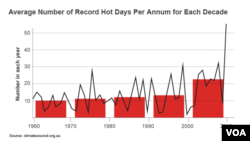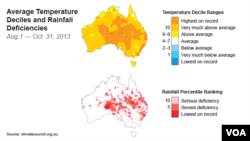SYDNEY —
Heat waves in Australia are becoming more common and severe, according to a report released on Thursday by the nation's Climate Council. The independent non-profit organization insists that extreme weather patterns can be attributed to climate change. The report comes as southern Australia braces for more punishing heat and emergency crews battle dozens of bushfires.
Temperatures in the southern city of Adelaide have been near 46 degrees Celsius, while Melbourne is on track to record its second-longest heat wave since the 1830s. Strong winds are likely to increase the bushfire danger later this week in South Australia and Victoria, where more than 1,000 fires have been reported. Some 40 are currently burning out of control.
The Climate Council said that periods of intense heat in Australia are becoming more frequent, hotter and are lasting longer. The council predicts that such heat waves will become increasingly severe in the future. Researchers blame climate change, and believe that the burning of fossil fuels is trapping more heat in the lower atmosphere.
Professor Will Steffen, one of the authors of the Climate Council report, said events spanning many years were studied.
“We are putting together [data] over many decades to look at longer term trends rather than individual events. It is when you do that that you start seeing those trends of longer heat waves, more frequent heat waves, hotter heat waves, and they are actually starting earlier in the season and this shows you that the basic fundamental characteristics of heat waves are indeed changing towards conditions that are worse in terms of human health and well-being,” said Steffen.
Health authorities in Australia have warned that extreme heat can kill. In February 2009, 173 people were killed when bushfires tore across the state of Victoria in what was known as the Black Saturday bushfire disaster.
In South Australia, dozens of people have been treated for heat-related illnesses and more ambulance crews have been put on duty; the number of patients is expected to rise later in the week.
Bill Griggs, from the Royal Adelaide Hospital, said the heat can cause a variety of medical issues or exacerbate existing ones.
“The commonest things are actually the deterioration in existing medical conditions, they can be affected by a degree of heat stress, but you get other simple things ranging from heat rash or prickly heat, some people get cramps, some can become dizzy and faint. But it's when you get more affected and run the risk of heat exhaustion or heat stroke,” said Griggs.
The extreme heat has also affected the world of sport, forcing matches at the Australian Open in Melbourne to be suspended. The punishing conditions are expected to continue into Friday, while a cool change is forecast over the weekend.
Scientists said that 2013 was Australia’s hottest year on record. In many parts of the country, 2014 has started in a similar fashion.
Temperatures in the southern city of Adelaide have been near 46 degrees Celsius, while Melbourne is on track to record its second-longest heat wave since the 1830s. Strong winds are likely to increase the bushfire danger later this week in South Australia and Victoria, where more than 1,000 fires have been reported. Some 40 are currently burning out of control.
The Climate Council said that periods of intense heat in Australia are becoming more frequent, hotter and are lasting longer. The council predicts that such heat waves will become increasingly severe in the future. Researchers blame climate change, and believe that the burning of fossil fuels is trapping more heat in the lower atmosphere.
Professor Will Steffen, one of the authors of the Climate Council report, said events spanning many years were studied.
“We are putting together [data] over many decades to look at longer term trends rather than individual events. It is when you do that that you start seeing those trends of longer heat waves, more frequent heat waves, hotter heat waves, and they are actually starting earlier in the season and this shows you that the basic fundamental characteristics of heat waves are indeed changing towards conditions that are worse in terms of human health and well-being,” said Steffen.
Health authorities in Australia have warned that extreme heat can kill. In February 2009, 173 people were killed when bushfires tore across the state of Victoria in what was known as the Black Saturday bushfire disaster.
In South Australia, dozens of people have been treated for heat-related illnesses and more ambulance crews have been put on duty; the number of patients is expected to rise later in the week.
Bill Griggs, from the Royal Adelaide Hospital, said the heat can cause a variety of medical issues or exacerbate existing ones.
“The commonest things are actually the deterioration in existing medical conditions, they can be affected by a degree of heat stress, but you get other simple things ranging from heat rash or prickly heat, some people get cramps, some can become dizzy and faint. But it's when you get more affected and run the risk of heat exhaustion or heat stroke,” said Griggs.
The extreme heat has also affected the world of sport, forcing matches at the Australian Open in Melbourne to be suspended. The punishing conditions are expected to continue into Friday, while a cool change is forecast over the weekend.
Scientists said that 2013 was Australia’s hottest year on record. In many parts of the country, 2014 has started in a similar fashion.












